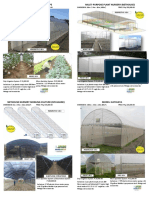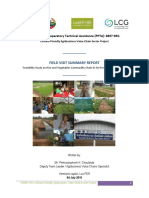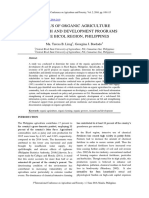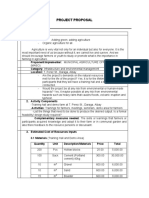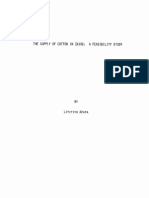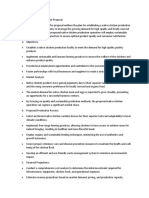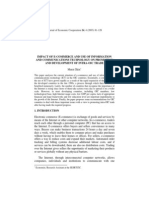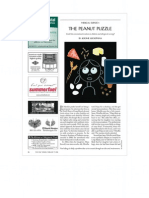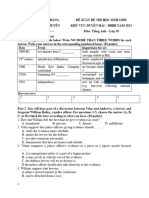Sample Project Proposal For Organc Farming
Sample Project Proposal For Organc Farming
Uploaded by
ani ni musCopyright:
Available Formats
Sample Project Proposal For Organc Farming
Sample Project Proposal For Organc Farming
Uploaded by
ani ni musOriginal Description:
Original Title
Copyright
Available Formats
Share this document
Did you find this document useful?
Is this content inappropriate?
Copyright:
Available Formats
Sample Project Proposal For Organc Farming
Sample Project Proposal For Organc Farming
Uploaded by
ani ni musCopyright:
Available Formats
Final Draft Project Concept Note - 14 July 2005 AARINENA /FAO-GFAR Organic Farming: Realizing a market growth opportunity:
Utilization and Enhancement of Organic Agriculture in the AARINENA Region in Dates, Olives, Medicinal Herbs and Cotton Sub-sectors.
I. Background 1. According to many reports, organic food is a growing business with good long-term prospects. Despite the heightened attention that organic agriculture has attracted during the last decade, it still only accounts for a small proportion of overall agricultural land: an average of about 2.3% for the countries of the European Union, 2.2% for Australia, 0.23% for the United States of America and 1.30% for Canada. Notably, organic agriculture is also gaining importance in a number of developing countries including, for example Uganda (1.39%) , Sri Lanka (0.65%) , Tunisia (0.36%), Egypt (0.19%) ,China (0.06%), India (0.03%) , and Philippines (0.02 %) (SOEL-Survey, February 2004). Even though it is a small portion, its rate of growth is very fast. 2. Organic agriculture is one among the broad spectrum of production methods that are supportive of the environment. Organic production systems are based on specific and precise standards of production which aim at achieving agro-ecosystems which are socially and ecologically sustainable. 3. Organic agriculture is based on minimizing the use of external inputs, avoiding the use of synthetic fertilizers and pesticides. And it goes beyond the application of certain technologies and requires a particular mind set or attitude on behalf of the producers. 4."Organic" is a labeling term that denotes products that have been produced in accordance with organic standards throughout production, handling, processing and marketing stages, and certified by a duly constituted certification body or authority. Situation now: The certified and policy supported organic production area in general and in particular in the AARINENA region countries vary widely in relation to growth rate and total area and there were no clear or defined figures about the size of production and total area of production. For many countries it is still difficult to find precise and up-to-date figures on the state of organic farming in individual countries, although it has become easier by the time. But still, in many cases no figures were available at all (Helga Willer and Minou, Yussefi (2004)). As long as government interest in organic agriculture is low, statistical information on organic agriculture rarely exists. In order to get a complete picture of the government certified organic farming all over the world , a survey among all organic certifies would need to be under taken. Organic agriculture comes as one of the top priorities, specifically with relation to food safety, diversification alternatives in agriculture production, income- generation for small and mediumscale farmers and improves access to regional and international markets, mainly through exports from developing countries. Organic agriculture can also play a role in achieving AARINENA four network's (Date palm, cotton, Olives, Medicinal Herbs) broad objectives of poverty reduction, food security and sustainable development. Organic Farming project's tasks through the four global networks are to develop and provide services that improve access to information for organic farming, and to strengthen the capacity of these networks to produce, acquire, exchange and utilize information in the AARINENA region. Organic Farming Project's programmes will be organized around five principal tasks:
i. ii.
iii. iv. v.
developing information management and partnership strategies needed for organic production policy formulation and implementation. promoting contact and exchange of experience: organizing and co-organizing conferences, seminars, workshops and study-visits on the four commodities organic farming priority information themes for the various stakeholders involved in organic farming. providing the networks members with information on the main issues and changes in organic farming through publications and co-publications strengthening the networks information and communication capacities through training courses and collaborative arrangements with regional and international organizations. conducting a survey in the AARINENA countries to collect needed information about the market for organic dates, cotton, medicinal plants and olives, volumes required, quality requirements , potential farmers and partners at local and regional levels, gaps and constraints , present situation and prospects for the future . This will put the basis for developing tools for identifying those areas and farmers that have the most likelihood of success.
Desired situation at the end of project: As a result of AARINENA networks involvement in this project in selected sub-sectors (olives, dates, cotton, medicinal and herbal plants), through the supporting of certain case studies in the region and organizing the information management approaches, Organic farming project will also be a good opportunity for AARINENA countries to develop new production methods and access new markets. Networks and its partners will get the support to the dissemination of phytosanitary rules and regulations needed to access the main northern markets, setting up local or regional certification programmes, initiating new or supporting existing capacity building programmes as well as promoting the exchange of experiences and information between the participated countries. II. Project description: Goal: Introduction, intensification and optimization of organic production, environmental protection and the promotion and supporting the access of AARINENA Networks country members organic products to local, regional and international markets. Purpose: The project has the specific purpose of the increased involvement of AARINENA Countries in promoting Organic Agriculture. Agriculture in many of those countries is characterized by many resource-poor smallholders. The introduction of OA could offer diverse benefits, such as income generation, natural resource conservation, food self-sufficiency and social development. Outputs and principal activities to achieve each output: Output 1-Information about the current situation in the concerned countries regarding market and organic production of olives, dates, cotton, medicinal and herbal plants is collected, and analysed. Activities: 1.1 -Carrying out the information survey. 1.2-Data Collection and analysis. 1.3-Interpretation of results, conclusions and recommendations. 1.4-Setting up the current situation in each country / region. Output 2-Organic Agriculture in selected sub-sectors (olive, date palm, and cotton, medicinal and herbal plants) in the targeted countries is strengthened. 2
Activities: 2.1-Setting- up new Information Centers (IC) / Focal points Equip with required information and technical literature. 2.2-Collection and analysis of existing information. 2.3-Development of individual work plans for each IC. 2.4-Development of contacts with the local OA movements to promote OA in the region / country. Output 3- Participation and capacity in the structures and membership of AARINENA networks is improved. Activities: 3.1- Ensure the active and successful representation of country members in AARINENA structures. 3.1.1- Provide financial support (travel, accommodation, expenses) to representatives from member countries for increased participation in decision-making bodies of AARINENA. 3.1.2- Facilitate capacity building for key persons at the regional level and in AARINENA committees and internal structures. 3.2-Develop and implement an appropriate policy to promote gender balance and regional balance further within AARINENA internal structures and committees. 3.2.1- Setting up an internet platform for training on OA. 3.2.2- organize or support targeted trainings for trainers to organize and finance the translations of important OA / FAO documents into major languages. Output 4- The Potential of Organic Agriculture in regard of Social, Environmental and Economic Benefits is recognized. Activities: 4.1-Development of a strategy to promote the potential of OA in its full diversity from income generation through biodiversity, food security and rural development. 4.2-Development of relevant position papers for the strategy. 4.3-Establish a participatory review of the Principles of Organic Agriculture (POA). 4.3.1- Capacity building to advocate for POA. 4.3.2- Development and implementation of mechanisms to broaden recognition of POA. 4.4-Identification of and linking up with existing organic programs and networks. 4.5-Promotion of AARINENAs mission and position at national and regional levels. 4.6-Collection, documentation and publication of good case studies about OA and food security. Output 5- Organic marketing is improved at all levels in AARINENA countries (local, regional and export marketing). Activities: 5.1-Facilitation of the development of local and regional markets. 5.1.1- Development of PGS (Participatory Guarantee Systems). 5.1.2 - Development of ICS (Internal Control Systems) for smallholders and linking up with local marketing 5.1.3- Support to targeted training and set up of PGS (Participatory Guarantee Systems) and local marketing systems. 5.1.4- Promotion of local organic marketing. 5.2- Support to the development of regional/national standards according to the standards of international markets. 5.2.1-Enhancing capacity building of existing certification bodies. 5.2.2- Training of operators in organic as well as EUROPGAP practices; which will be a must for penetrating international markets.
Output 6- Advisory strategy, including consultancies and development agencies, for AARINENA countries with an emerging sub-sector (olive, date palm, and cotton, medicinal and herbal plants) organic products is developed and implemented. Activities: 6.1-Develop a strategy for advice / governments support, e.g. in regulations, capacity building, extension, etc. 6.2-Develop and produce a comprehensive information package. 6.3-Support governments on request. 6.4-Involve consultancies working with governments to implement the OA /AARINENA advisory strategy, and to actively use OA/AARINENA information package. 6.5-Lobbying of development agencies to implement OA/AARINENA information package in their project / program planning and approach.
III.Project Justification: 1. Although there is a general growth in organic movement, some countries in the AARINENA region are lagging behind. However there is a lack of information, knowledge and expertise in many of these countries. In order to close the gaps in the Organic Agriculture map of the region, and to provide necessary information, knowledge and expertise in the targeted sub-sectors and countries, this project plans to set up Information Points at the national or regional level in the area with an emerging organic sector. 2. Most of AARINENA network members are working on food security issues, sustainable rural development, and poverty alleviation. They are looking for equal participation in the worldwide organic movement, and markets, and their efficient participation is needed in this global movement for an acceptable, balanced and fair development. Promoting legal and institutional reviews, and subsequent reform, and mobilizing financial resources from multi and bilateral donors and cooperation agencies for integrated water management; 3. Organic Agriculture is often associated with export agriculture. For many, especially for policy-makers in developing countries, Organic Agriculture is associated to rigid rules and complicated practices that allow marketing certified organic food products. 4. Export markets demand huge quantities of standardized high quality products. Agrobusiness companies can cope with these requirements but a large number of small-scale farmers in developing countries are left behind by globalization. 5. For early development of this organic sub- sector the better strategy is to start with the foundations, thus providing the Networks with global platform for the organic agriculture movements and this certainly can encourage the governments to take an interest in this organic sector and regulating its process. The present proposal aims to bring together all stakeholders, including small and medium-scale farmers to develop a strategy to work on advice / for government support, e.g. in regulations, capacity building, extension, promotion, and others. To develop a comprehensive information and exchange package covering all important sub-sectors organic agriculture, like the Organic Guarantee System, promotion materials, training materials on organic agriculture and marketing, etc. A special focus will be given to development agencies, as well as to the research centers working in this field in developing and disseminating the package.
IV. Innovative nature of the project: The project will build on the following experiences: The IFOAM Mediterranean Regional Group AgroBioMediterraneo: 16 Mediterranean countries are involved in AgriBioMediterraneo: Albania, Bosnia-Herzegovina, Croatia, Cyprus, Egypt, France, Greece, Israel, Italy, Palestine, Portugal, Serbia & Montenegro, Slovenia, Spain, Tunisia and Turkey. AgriBioMediterraneo has two major aims: To promote, develop and disseminate information, knowledge and expertise related to Mediterranean organic agriculture and food production. The development of AgriBioTourism on family farms. Training, certification body, technology transfer, and research in the organic products in Egypt. The organic agriculture movement was born in Egypt some 20 years ago, chiefly to alleviate the increasing threat of pesticide poisoning to Egyptian farmers. In the early 1990s, SEKEM starting applying biodynamic methods (already in use for herbs, cereals, and vegetables) to cotton. The Centre for Organic Agriculture in Egypt operates an inspection and certification scheme according to the EU Regulation 2092/91. Integrated Pest Management (IPM) in Jordan: A series of projects were implemented to gradually eliminate the usage of chemical fertilizers and pesticides in agriculture production. With the GTZ technical and financial support this project were implemented in Jordan and Tunisia. The organic spirit in Saudi Arabia: It began around 1994 in Al-Jouf with Sheik Sulaimans Al-Rahji Company for Agriculture, and his decision to stop using any chemicals on the fruit farms, what amounted to more than 50,000 apple, peach, apricot and pear trees. The Emergence of Organic Agriculture in Morocco: In 1992 the organic movement has spread north and south to the main agricultural areas .The overall surface allocated to organic production is currently estimated to 11,956 ha, among which 35% is still under conversion. The main products are citrus, vegetables, medicinal plants and argon oil. The entire development of the organic agriculture in Croatia has been NGO-driven. Its further expansion depends on the still limited interest of the farmers, and above all- a more serious commitment of the government. Organic Agriculture in Turkey: organic agriculture started in 1984-85 with the demand coming from European importers for organically grown dried figs and raisins.
New and innovative approaches which the project will use: The scaling and development of domestic organic food markets which is essential for the sustainable growth of organic agriculture and for sustainable rural development in general. There is a need for the development of a balance between growth in OA and the demand for organic products. This true knows that not all producers in developing countries can export their organic products to a few markets in the North. Competition is already increasing. There are a number of successful cases of local market developments on all continents. Experiences need to be exchanged, compiled and evaluated; effective models and tools drawn up and disseminated in order to develop organic markets in AARINENA country members, and lead to growth in organic agriculture.
V. Target beneficiaries: -Small and medium sized- scale farmers, Processors, Exporters and Consumers.
VI. Institutions that might participate and their roles: In general AARINENA Networks (olive, date palm, Medicinal Herb plants and cotton) member countries: Within each country the following institutions will participate: - Government institutions (GO): Harmonized rules and food control measures. - Non-Governmental Organizations (NGOs): Training, Information dissemination and sustainable agriculture development. - Farmers Organizations (FOs): Training, Information dissemination and sustainable agriculture development. - Research centers /National Agriculture Research Centers (NARs): Research and training. - Associations and rural communities (CSOs): Sustainable agriculture development and information dissemination. - Organic Agriculture movements and projects: Training and capacity building. - Existing certified bodies or organizations (CB): Certification, communications and exchange of experiences. In particular the following countries will participate in Phase I of the project which will be considered as a pilot project and could be replicated in the other AARINENA country members in the next phases. Countries and Institutions: Jordan : Project Coordination and acting as Focal Point and Information Center (IC) for the Medicinal Herb plants Network . Institutions: Noor AlHussein Foundation (NHF)(NGOs) /ANSAD(Network), FAO regional office Amman(International Organisation) , NCARTT (NARs), Ministry of Agriculture(GO) , Agriculture Engineers Association (CSOs), Jordan University of Science and Technology (CSOs), General Jordanian Farmers Union (FOs) . United Arab Emirates: Acting as Focal Point and Information Center (IC) for the Date Palm Network . Institutions: UAE University (CSOs), Date Palm Friends Society(NGOs) , Emirates Dates Factory Alsaed (Private Sector) ,.... Egypt : Acting as Focal Point and Information Center (IC) for the olive Network . Institutions:Egyptian Association for supporting Olive Growers (EASOG)(CSOs),AGROFOOD Co.(Private Sector),FAO Regional Office Egypt(International Organisation),The Union of Growers and Exporters of Organic and Biodynamic Agriculture (UGEOBA)(CSOs) and the Egyptian Center of Organic Agriculture (ECOA)(NARs). Institutions from outside the region that should participate: International federation of Organic Agriculture Movements - IFOAM is the worldwide umbrella organization of the organic agriculture movement, with about 720 members from 100 countries all over the world. German Technical Cooperation Agency (GTZ): Division 45-Rural Development. World Health Organization (WHO). The Food and Agriculture Organization of the United Nations (FAO). 6
The International Trade Center UNCTAD/WTO (ITC). The Technical Center for Agricultural and Rural Cooperation (CTA). The World Conservation Union (IUCN)-WESCANA Regional Office .
Project duration and budget: Duration: 1 year.
- The project will conducted on three phases (I,II, and III). - Phase I: Data base and information collection, establishing the Information Points, Research and Training. -Phase II: Training , capacity building and iformation dissemination, Establishing the Certification body and choosing the projects. - Phase III:Projects Indentification,Project PLaning and implementation,communication and exchange of Experiences.
Budget:
225,000 US $.
Tentative Budget (US $) Phase I Activities Type Unit 1.1 -Carrying out the information Survey (3) survey. Egypt 1.2-Data Collection and analysis. Jordan 1.3-Interpretation of results, conclusions Emirates and recommendations. 1.4-Setting up the current situation in each country / region. Sub Total 2.1-Setting- up new Information Centers (IC)Office (3) (IC) / Focal points Equip with required information and technical literature. 2.2-Collection and analysis of existing Questionnaire (3) information. 2.3-Development of individual work Consultant (3) plans for each IC. 2.4-Development of contacts with the PCs and contact (3) local OA movements to promote OA in Equipments / the country. Installations Sub Total 3.1- Ensure the active and successful representation of country members in AARINENA structures. 3.1.1- Provide financial support (travel, accommodation, expenses) to representatives from member countries
Cost / Unit 10, 000
Total 30,000
10,000
30,000 30,000
5,000 2,000 5,000
15,000 6,000 15,000
66,000
Travel and (9) Accommodation
2,000
18,000
for increased participation in decisionmaking bodies of AARINENA. 3.1.2- Facilitate capacity building for key persons at the regional level and in AARINENA committees and internal structures. 3.2-Develop and implement an appropriate policy to promote gender balance and regional balance further within AARINENA internal structures and committees. 3.2.1- Setting up an internet platform for training on OA. 3.2.2- organizes or support targeted trainings for trainers to organize and finance the translations of important OA / FAO documents into major languages. Sub Total Overheads and Coordination Sub Total Grand Total
Training
(6)
4,000
24,000
Workshops and Seminars
(6)
4,000
24,000
Internet installation
(3)
2,000
6,000
TOT Translation
(6) (3)
5,000 3,000
30,000 9,000 111,000 18,000 225,000
Coordinator
(1)
18,000
Project Team: 1) Mr. Nabeel Abu-Shriha : Team Leader , Agronomist , AARINENA NGOs Focal point . abushriha@mail.com / n_abushriha@hotmail.com. ( Head, Agricultural and Environmental Projects Unit) Amman, Jordan. 2) Dr. Abdelfattah Elzahwey: Medicinal & Aromatic Department Dokki, Giza-Cairo / EGYPT. elzahwey@yahoo.com. 3) Dr. Salah Hegazy Mohamed : AGROFOOD Co.Cairo /Egypt . salah@agrofood.com.eg 4) Dr. Salam Ayoub: National Center for Agricultural Research &Technology Transfer (NCARTT) Amman /Jordan. salamayoub@hotmail.com. / sayoub@ncartt.gov.jo. 5 ) Mr. Tawfiq Sallam Mohamed : Y-HIGH EXPORT SUPREME COUNCIL SANAA/YEMEN . tsmps@yahoo.com. Immediate next steps: Prepare and finalize the concept note: July 8, 2005. Submission of the Concept Note to GFAR and AARINENA: July 16,2005. Exploration and presentation to selected AARINENA committee members. Proposal writing and document preparation. Identification of sources of fund and expected donors. Re-formulation of the draft project to selected donors. Following acceptance of Concept Note by donors. Submission of project to donors. Letter of Agreement (LOA) and official signing of the project with donors. Executing plans and project implementation.
Donors who might be interested in funding this project: ALL International donor agencies and bodies: UNDP, World bank, USAID, GEF, GTZ, UNEP, IFAD e Final Draft Project Concept Note - 14 July 2005 8
AARINENA /FAO-GFAR Organic Farming: Realizing a market growth opportunity: Utilization and Enhancement of Organic Agriculture in the AARINENA Region in Dates, Olives, Medicinal Herbs and Cotton Sub-sectors.
I. Background 1. According to many reports, organic food is a growing business with good long-term prospects. Despite the heightened attention that organic agriculture has attracted during the last decade, it still only accounts for a small proportion of overall agricultural land: an average of about 2.3% for the countries of the European Union, 2.2% for Australia, 0.23% for the United States of America and 1.30% for Canada. Notably, organic agriculture is also gaining importance in a number of developing countries including, for example Uganda (1.39%) , Sri Lanka (0.65%) , Tunisia (0.36%), Egypt (0.19%) ,China (0.06%), India (0.03%) , and Philippines (0.02 %) (SOEL-Survey, February 2004). Even though it is a small portion, its rate of growth is very fast. 2. Organic agriculture is one among the broad spectrum of production methods that are supportive of the environment. Organic production systems are based on specific and precise standards of production which aim at achieving agro-ecosystems which are socially and ecologically sustainable. 3. Organic agriculture is based on minimizing the use of external inputs, avoiding the use of synthetic fertilizers and pesticides. And it goes beyond the application of certain technologies and requires a particular mind set or attitude on behalf of the producers. 4."Organic" is a labeling term that denotes products that have been produced in accordance with organic standards throughout production, handling, processing and marketing stages, and certified by a duly constituted certification body or authority. Situation now: The certified and policy supported organic production area in general and in particular in the AARINENA region countries vary widely in relation to growth rate and total area and there were no clear or defined figures about the size of production and total area of production. For many countries it is still difficult to find precise and up-to-date figures on the state of organic farming in individual countries, although it has become easier by the time. But still, in many cases no figures were available at all (Helga Willer and Minou, Yussefi (2004)). As long as government interest in organic agriculture is low, statistical information on organic agriculture rarely exists. In order to get a complete picture of the government certified organic farming all over the world , a survey among all organic certifies would need to be under taken. Organic agriculture comes as one of the top priorities, specifically with relation to food safety, diversification alternatives in agriculture production, income- generation for small and mediumscale farmers and improves access to regional and international markets, mainly through exports from developing countries. Organic agriculture can also play a role in achieving AARINENA four network's (Date palm, cotton, Olives, Medicinal Herbs) broad objectives of poverty reduction, food security and sustainable development. Organic Farming project's tasks through the four global networks are to develop and provide services that improve access to information for organic farming, and to strengthen the capacity of these networks to produce, acquire, exchange and utilize information in the AARINENA region. Organic Farming Project's programmes will be organized around five principal tasks:
vi. vii.
viii. ix. x.
developing information management and partnership strategies needed for organic production policy formulation and implementation. promoting contact and exchange of experience: organizing and co-organizing conferences, seminars, workshops and study-visits on the four commodities organic farming priority information themes for the various stakeholders involved in organic farming. providing the networks members with information on the main issues and changes in organic farming through publications and co-publications strengthening the networks information and communication capacities through training courses and collaborative arrangements with regional and international organizations. conducting a survey in the AARINENA countries to collect needed information about the market for organic dates, cotton, medicinal plants and olives, volumes required, quality requirements , potential farmers and partners at local and regional levels, gaps and constraints , present situation and prospects for the future . This will put the basis for developing tools for identifying those areas and farmers that have the most likelihood of success.
Desired situation at the end of project: As a result of AARINENA networks involvement in this project in selected sub-sectors (olives, dates, cotton, medicinal and herbal plants), through the supporting of certain case studies in the region and organizing the information management approaches, Organic farming project will also be a good opportunity for AARINENA countries to develop new production methods and access new markets. Networks and its partners will get the support to the dissemination of phytosanitary rules and regulations needed to access the main northern markets, setting up local or regional certification programmes, initiating new or supporting existing capacity building programmes as well as promoting the exchange of experiences and information between the participated countries. II. Project description: Goal: Introduction, intensification and optimization of organic production, environmental protection and the promotion and supporting the access of AARINENA Networks country members organic products to local, regional and international markets. Purpose: The project has the specific purpose of the increased involvement of AARINENA Countries in promoting Organic Agriculture. Agriculture in many of those countries is characterized by many resource-poor smallholders. The introduction of OA could offer diverse benefits, such as income generation, natural resource conservation, food self-sufficiency and social development. Outputs and principal activities to achieve each output: Output 1-Information about the current situation in the concerned countries regarding market and organic production of olives, dates, cotton, medicinal and herbal plants is collected, and analysed. Activities: 1.1 -Carrying out the information survey. 1.2-Data Collection and analysis. 1.3-Interpretation of results, conclusions and recommendations. 1.4-Setting up the current situation in each country / region. Output 2-Organic Agriculture in selected sub-sectors (olive, date palm, and cotton, medicinal and herbal plants) in the targeted countries is strengthened. 10
Activities: 2.1-Setting- up new Information Centers (IC) / Focal points Equip with required information and technical literature. 2.2-Collection and analysis of existing information. 2.3-Development of individual work plans for each IC. 2.4-Development of contacts with the local OA movements to promote OA in the region / country. Output 3- Participation and capacity in the structures and membership of AARINENA networks is improved. Activities: 3.1- Ensure the active and successful representation of country members in AARINENA structures. 3.1.1- Provide financial support (travel, accommodation, expenses) to representatives from member countries for increased participation in decision-making bodies of AARINENA. 3.1.2- Facilitate capacity building for key persons at the regional level and in AARINENA committees and internal structures. 3.2-Develop and implement an appropriate policy to promote gender balance and regional balance further within AARINENA internal structures and committees. 3.2.1- Setting up an internet platform for training on OA. 3.2.2- organize or support targeted trainings for trainers to organize and finance the translations of important OA / FAO documents into major languages. Output 4- The Potential of Organic Agriculture in regard of Social, Environmental and Economic Benefits is recognized. Activities: 4.1-Development of a strategy to promote the potential of OA in its full diversity from income generation through biodiversity, food security and rural development. 4.2-Development of relevant position papers for the strategy. 4.3-Establish a participatory review of the Principles of Organic Agriculture (POA). 4.3.1- Capacity building to advocate for POA. 4.3.2- Development and implementation of mechanisms to broaden recognition of POA. 4.4-Identification of and linking up with existing organic programs and networks. 4.5-Promotion of AARINENAs mission and position at national and regional levels. 4.6-Collection, documentation and publication of good case studies about OA and food security. Output 5- Organic marketing is improved at all levels in AARINENA countries (local, regional and export marketing). Activities: 5.1-Facilitation of the development of local and regional markets. 5.1.1- Development of PGS (Participatory Guarantee Systems). 5.1.2 - Development of ICS (Internal Control Systems) for smallholders and linking up with local marketing 5.1.3- Support to targeted training and set up of PGS (Participatory Guarantee Systems) and local marketing systems. 5.1.4- Promotion of local organic marketing. 5.2- Support to the development of regional/national standards according to the standards of international markets. 5.2.1-Enhancing capacity building of existing certification bodies. 5.2.2- Training of operators in organic as well as EUROPGAP practices; which will be a must for penetrating international markets.
11
Output 6- Advisory strategy, including consultancies and development agencies, for AARINENA countries with an emerging sub-sector (olive, date palm, and cotton, medicinal and herbal plants) organic products is developed and implemented. Activities: 6.1-Develop a strategy for advice / governments support, e.g. in regulations, capacity building, extension, etc. 6.2-Develop and produce a comprehensive information package. 6.3-Support governments on request. 6.4-Involve consultancies working with governments to implement the OA /AARINENA advisory strategy, and to actively use OA/AARINENA information package. 6.5-Lobbying of development agencies to implement OA/AARINENA information package in their project / program planning and approach.
III.Project Justification: 6. Although there is a general growth in organic movement, some countries in the AARINENA region are lagging behind. However there is a lack of information, knowledge and expertise in many of these countries. In order to close the gaps in the Organic Agriculture map of the region, and to provide necessary information, knowledge and expertise in the targeted sub-sectors and countries, this project plans to set up Information Points at the national or regional level in the area with an emerging organic sector. 7. Most of AARINENA network members are working on food security issues, sustainable rural development, and poverty alleviation. They are looking for equal participation in the worldwide organic movement, and markets, and their efficient participation is needed in this global movement for an acceptable, balanced and fair development. Promoting legal and institutional reviews, and subsequent reform, and mobilizing financial resources from multi and bilateral donors and cooperation agencies for integrated water management; 8. Organic Agriculture is often associated with export agriculture. For many, especially for policy-makers in developing countries, Organic Agriculture is associated to rigid rules and complicated practices that allow marketing certified organic food products. 9. Export markets demand huge quantities of standardized high quality products. Agrobusiness companies can cope with these requirements but a large number of small-scale farmers in developing countries are left behind by globalization. 10. For early development of this organic sub- sector the better strategy is to start with the foundations, thus providing the Networks with global platform for the organic agriculture movements and this certainly can encourage the governments to take an interest in this organic sector and regulating its process. The present proposal aims to bring together all stakeholders, including small and medium-scale farmers to develop a strategy to work on advice / for government support, e.g. in regulations, capacity building, extension, promotion, and others. To develop a comprehensive information and exchange package covering all important sub-sectors organic agriculture, like the Organic Guarantee System, promotion materials, training materials on organic agriculture and marketing, etc. A special focus will be given to development agencies, as well as to the research centers working in this field in developing and disseminating the package.
12
IV. Innovative nature of the project: The project will build on the following experiences: The IFOAM Mediterranean Regional Group AgroBioMediterraneo: 16 Mediterranean countries are involved in AgriBioMediterraneo: Albania, Bosnia-Herzegovina, Croatia, Cyprus, Egypt, France, Greece, Israel, Italy, Palestine, Portugal, Serbia & Montenegro, Slovenia, Spain, Tunisia and Turkey. AgriBioMediterraneo has two major aims: To promote, develop and disseminate information, knowledge and expertise related to Mediterranean organic agriculture and food production. The development of AgriBioTourism on family farms. Training, certification body, technology transfer, and research in the organic products in Egypt. The organic agriculture movement was born in Egypt some 20 years ago, chiefly to alleviate the increasing threat of pesticide poisoning to Egyptian farmers. In the early 1990s, SEKEM starting applying biodynamic methods (already in use for herbs, cereals, and vegetables) to cotton. The Centre for Organic Agriculture in Egypt operates an inspection and certification scheme according to the EU Regulation 2092/91. Integrated Pest Management (IPM) in Jordan: A series of projects were implemented to gradually eliminate the usage of chemical fertilizers and pesticides in agriculture production. With the GTZ technical and financial support this project were implemented in Jordan and Tunisia. The organic spirit in Saudi Arabia: It began around 1994 in Al-Jouf with Sheik Sulaimans Al-Rahji Company for Agriculture, and his decision to stop using any chemicals on the fruit farms, what amounted to more than 50,000 apple, peach, apricot and pear trees. The Emergence of Organic Agriculture in Morocco: In 1992 the organic movement has spread north and south to the main agricultural areas .The overall surface allocated to organic production is currently estimated to 11,956 ha, among which 35% is still under conversion. The main products are citrus, vegetables, medicinal plants and argon oil. The entire development of the organic agriculture in Croatia has been NGO-driven. Its further expansion depends on the still limited interest of the farmers, and above all- a more serious commitment of the government. Organic Agriculture in Turkey: organic agriculture started in 1984-85 with the demand coming from European importers for organically grown dried figs and raisins.
New and innovative approaches which the project will use: The scaling and development of domestic organic food markets which is essential for the sustainable growth of organic agriculture and for sustainable rural development in general. There is a need for the development of a balance between growth in OA and the demand for organic products. This true knows that not all producers in developing countries can export their organic products to a few markets in the North. Competition is already increasing. There are a number of successful cases of local market developments on all continents. Experiences need to be exchanged, compiled and evaluated; effective models and tools drawn up and disseminated in order to develop organic markets in AARINENA country members, and lead to growth in organic agriculture.
13
V. Target beneficiaries: -Small and medium sized- scale farmers, Processors, Exporters and Consumers.
VI. Institutions that might participate and their roles: In general AARINENA Networks (olive, date palm, Medicinal Herb plants and cotton) member countries: Within each country the following institutions will participate: - Government institutions (GO): Harmonized rules and food control measures. - Non-Governmental Organizations (NGOs): Training, Information dissemination and sustainable agriculture development. - Farmers Organizations (FOs): Training, Information dissemination and sustainable agriculture development. - Research centers /National Agriculture Research Centers (NARs): Research and training. - Associations and rural communities (CSOs): Sustainable agriculture development and information dissemination. - Organic Agriculture movements and projects: Training and capacity building. - Existing certified bodies or organizations (CB): Certification, communications and exchange of experiences. In particular the following countries will participate in Phase I of the project which will be considered as a pilot project and could be replicated in the other AARINENA country members in the next phases. Countries and Institutions: Jordan : Project Coordination and acting as Focal Point and Information Center (IC) for the Medicinal Herb plants Network . Institutions: Noor AlHussein Foundation (NHF)(NGOs) /ANSAD(Network), FAO regional office Amman(International Organisation) , NCARTT (NARs), Ministry of Agriculture(GO) , Agriculture Engineers Association (CSOs), Jordan University of Science and Technology (CSOs), General Jordanian Farmers Union (FOs) . United Arab Emirates: Acting as Focal Point and Information Center (IC) for the Date Palm Network . Institutions: UAE University (CSOs), Date Palm Friends Society(NGOs) , Emirates Dates Factory Alsaed (Private Sector) ,.... Egypt : Acting as Focal Point and Information Center (IC) for the olive Network . Institutions:Egyptian Association for supporting Olive Growers (EASOG)(CSOs),AGROFOOD Co.(Private Sector),FAO Regional Office Egypt(International Organisation),The Union of Growers and Exporters of Organic and Biodynamic Agriculture (UGEOBA)(CSOs) and the Egyptian Center of Organic Agriculture (ECOA)(NARs). Institutions from outside the region that should participate: International federation of Organic Agriculture Movements - IFOAM is the worldwide umbrella organization of the organic agriculture movement, with about 720 members from 100 countries all over the world. German Technical Cooperation Agency (GTZ): Division 45-Rural Development. World Health Organization (WHO). The Food and Agriculture Organization of the United Nations (FAO). 14
The International Trade Center UNCTAD/WTO (ITC). The Technical Center for Agricultural and Rural Cooperation (CTA). The World Conservation Union (IUCN)-WESCANA Regional Office .
Project duration and budget: Duration: 1 year.
- The project will conducted on three phases (I,II, and III). - Phase I: Data base and information collection, establishing the Information Points, Research and Training. -Phase II: Training , capacity building and iformation dissemination, Establishing the Certification body and choosing the projects. - Phase III:Projects Indentification,Project PLaning and implementation,communication and exchange of Experiences.
Budget:
225,000 US $.
Tentative Budget (US $) Phase I Activities Type Unit 1.1 -Carrying out the information Survey (3) survey. Egypt 1.2-Data Collection and analysis. Jordan 1.3-Interpretation of results, conclusions Emirates and recommendations. 1.4-Setting up the current situation in each country / region. Sub Total 2.1-Setting- up new Information Centers (IC)Office (3) (IC) / Focal points Equip with required information and technical literature. 2.2-Collection and analysis of existing Questionnaire (3) information. 2.3-Development of individual work Consultant (3) plans for each IC. 2.4-Development of contacts with the PCs and contact (3) local OA movements to promote OA in Equipments / the country. Installations Sub Total 3.1- Ensure the active and successful representation of country members in AARINENA structures. 3.1.1- Provide financial support (travel, accommodation, expenses) to representatives from member countries
Cost / Unit 10, 000
Total 30,000
10,000
30,000 30,000
5,000 2,000 5,000
15,000 6,000 15,000
66,000
Travel and (9) Accommodation
2,000
18,000
15
for increased participation in decisionmaking bodies of AARINENA. 3.1.2- Facilitate capacity building for key persons at the regional level and in AARINENA committees and internal structures. 3.2-Develop and implement an appropriate policy to promote gender balance and regional balance further within AARINENA internal structures and committees. 3.2.1- Setting up an internet platform for training on OA. 3.2.2- organizes or support targeted trainings for trainers to organize and finance the translations of important OA / FAO documents into major languages. Sub Total Overheads and Coordination Sub Total Grand Total
Training
(6)
4,000
24,000
Workshops and Seminars
(6)
4,000
24,000
Internet installation
(3)
2,000
6,000
TOT Translation
(6) (3)
5,000 3,000
30,000 9,000 111,000 18,000 225,000
Coordinator
(1)
18,000
16
Project Team: 4) Mr. Nabeel Abu-Shriha : Team Leader , Agronomist , AARINENA NGOs Focal point . abushriha@mail.com / n_abushriha@hotmail.com. ( Head, Agricultural and Environmental Projects Unit) Amman, Jordan. 5) Dr. Abdelfattah Elzahwey: Medicinal & Aromatic Department Dokki, Giza-Cairo / EGYPT. elzahwey@yahoo.com. 6) Dr. Salah Hegazy Mohamed : AGROFOOD Co.Cairo /Egypt . salah@agrofood.com.eg 4) Dr. Salam Ayoub: National Center for Agricultural Research &Technology Transfer (NCARTT) Amman /Jordan. salamayoub@hotmail.com. / sayoub@ncartt.gov.jo. 5 ) Mr. Tawfiq Sallam Mohamed : Y-HIGH EXPORT SUPREME COUNCIL SANAA/YEMEN . tsmps@yahoo.com. Immediate next steps: Prepare and finalize the concept note: July 8, 2005. Submission of the Concept Note to GFAR and AARINENA: July 16,2005. Exploration and presentation to selected AARINENA committee members. Proposal writing and document preparation. Identification of sources of fund and expected donors. Re-formulation of the draft project to selected donors. Following acceptance of Concept Note by donors. Submission of project to donors. Letter of Agreement (LOA) and official signing of the project with donors. Executing plans and project implementation.
Donors who might be interested in funding this project: ALL International donor agencies and bodies: UNDP, World bank, USAID, GEF, GTZ, UNEP, IFAD Etc.
tc.
17
You might also like
- Fruit Business PlanDocument18 pagesFruit Business PlanAyebakuro Mohammed100% (2)
- 1-RICE Full ProposalDocument118 pages1-RICE Full Proposalanna reham lucmanNo ratings yet
- Project Proposals in Seling of Fruit Trees, Trees and Vegetables To The CommunityDocument7 pagesProject Proposals in Seling of Fruit Trees, Trees and Vegetables To The CommunityMarsha Law AndyouNo ratings yet
- Concept Note - Integrated FarmingDocument6 pagesConcept Note - Integrated Farmingsunthar82No ratings yet
- Feasibility StudyDocument79 pagesFeasibility StudyErwin Sanchez Colcol100% (2)
- Project Proposal For 100 Has Banana ProductionDocument18 pagesProject Proposal For 100 Has Banana ProductionOrsua Janine April67% (21)
- Empowering Small Rice FarmersDocument8 pagesEmpowering Small Rice FarmersNoel SalazarNo ratings yet
- Coconut Development PlanDocument20 pagesCoconut Development Planmarkgil1990100% (2)
- Plantation Cost EstimatesDocument26 pagesPlantation Cost EstimatesAlin Zivuanu100% (1)
- Business Plan 2011 - 2015Document29 pagesBusiness Plan 2011 - 2015Dominic Isaka100% (2)
- Organic Farm Business PlanDocument28 pagesOrganic Farm Business PlanHimadri Himu100% (4)
- Amazon Case Study - Part OneDocument4 pagesAmazon Case Study - Part Oneani ni musNo ratings yet
- Apostila Pre-Intermediate - CompletaDocument71 pagesApostila Pre-Intermediate - CompletaRamanNo ratings yet
- Agri Plas GreenhouseDocument8 pagesAgri Plas GreenhouseramukolakiNo ratings yet
- Project ProposalDocument13 pagesProject Proposalimeldavalenzuela07081955100% (2)
- Business Plan For Setting Up An OrganicDocument40 pagesBusiness Plan For Setting Up An OrganicRISHI VERMANo ratings yet
- Level I - Simple Business PlanDocument9 pagesLevel I - Simple Business Planagnes100% (1)
- Project Proposal On Organic FarmingDocument17 pagesProject Proposal On Organic Farmingani ni mus76% (29)
- Corn Roadmap 2011-2017Document32 pagesCorn Roadmap 2011-2017philmaize100% (5)
- Vermicomposting Prefeasibility-33Document18 pagesVermicomposting Prefeasibility-33Srikanth Chowdary Koritala100% (2)
- Feasibility Study On Rice and VegetablesDocument52 pagesFeasibility Study On Rice and VegetablesNICE TanzaniaNo ratings yet
- Organic FarmingDocument25 pagesOrganic FarmingPradyumna Athalye100% (1)
- Status of Organic Agriculture Research and Development Programs in The Bicol Region, PhilippinesDocument8 pagesStatus of Organic Agriculture Research and Development Programs in The Bicol Region, PhilippinesMario Montes100% (1)
- Project Profile On Production of Vermicompost 1 PDFDocument2 pagesProject Profile On Production of Vermicompost 1 PDFsuryasharma888878% (9)
- Best Fertilizer For Maize - Organic, NPK, Compost Manure, and ScheduleDocument9 pagesBest Fertilizer For Maize - Organic, NPK, Compost Manure, and ScheduleJoash MabsNo ratings yet
- Production of Organic Vegetable SeedsDocument99 pagesProduction of Organic Vegetable SeedsSchool Vegetable GardeningNo ratings yet
- Tribu Imalawa Gubang Ofw Association - Project Proposal (Cattle Raising)Document4 pagesTribu Imalawa Gubang Ofw Association - Project Proposal (Cattle Raising)Meine VidadNo ratings yet
- Attracting Youth in Agriculture in Asia Final PaperDocument45 pagesAttracting Youth in Agriculture in Asia Final PaperKendy Marr Salvador100% (1)
- Agricultural MarketingDocument45 pagesAgricultural MarketingShahidHussainBashovi100% (2)
- Sample Farm Plan For 100 Acres of Land PDFDocument17 pagesSample Farm Plan For 100 Acres of Land PDFNatalie DouglasNo ratings yet
- Cassava Value Chain AnalysisDocument91 pagesCassava Value Chain AnalysisArnel M. MapaNo ratings yet
- Proposal For Sustainable AgricultureDocument5 pagesProposal For Sustainable AgricultureJophet Galicia100% (1)
- Dragon Fruit Proposal (CWHF)Document13 pagesDragon Fruit Proposal (CWHF)Coronwokers HomebaseNo ratings yet
- Pnaar 802Document103 pagesPnaar 802sultannesru2030No ratings yet
- Concept Note For REAP-CIRCDocument12 pagesConcept Note For REAP-CIRCImran SheikhNo ratings yet
- Corn Production Demonstration FarmDocument12 pagesCorn Production Demonstration FarmALLAN SANORIA0% (1)
- Coconut Vegetable Cropping ModelDocument25 pagesCoconut Vegetable Cropping Modelardeng02No ratings yet
- Maize ProductionDocument10 pagesMaize ProductionNsereko Ssekamatte100% (1)
- Business Plan For " Rite Rice Farm Enterprise "Document12 pagesBusiness Plan For " Rite Rice Farm Enterprise "Andrew A Abraham100% (2)
- Technical Proposal (Igp For Women) I. Proposal Information SheetDocument9 pagesTechnical Proposal (Igp For Women) I. Proposal Information SheetALLAN SANORIA100% (1)
- WarehousepropsalDocument13 pagesWarehousepropsalKasandra Ng100% (1)
- Agribusiness Study PhilippinesDocument16 pagesAgribusiness Study PhilippinesDenis SalvatierraNo ratings yet
- PROJECT PROPOSAL VermicompostingDocument5 pagesPROJECT PROPOSAL VermicompostingFe Pilosopo100% (5)
- GreenHouse - KUDocument7 pagesGreenHouse - KUPrajan ShresthaNo ratings yet
- Projected Income StatementDocument9 pagesProjected Income StatementJake DonNo ratings yet
- Guidelines TDFDocument29 pagesGuidelines TDFPrabha Chelladurai100% (3)
- PDFDocument12 pagesPDFwayla waylaNo ratings yet
- Seed Distribution & MarketingDocument17 pagesSeed Distribution & MarketingJanjit AdhikariNo ratings yet
- Organic FarmingDocument197 pagesOrganic FarmingChiQuocLai50% (2)
- Duckery ProjectDocument2 pagesDuckery ProjectChester Dangli100% (1)
- Situation of Organic Agriculture in The PhilippinesDocument13 pagesSituation of Organic Agriculture in The PhilippinesRhona Dianne P. VasquezNo ratings yet
- Banana Project Report SampleDocument5 pagesBanana Project Report SampleNazeef Mhmd Zahir0% (1)
- Project ProposalDocument8 pagesProject ProposalUgyen TsheringNo ratings yet
- Proposal Native ChickenDocument2 pagesProposal Native ChickenJaypee Mar Alicante100% (1)
- Organic Fertilizer Project ProposalDocument13 pagesOrganic Fertilizer Project Proposalsewmelkam1985100% (2)
- Coco Seedling Business PlanDocument14 pagesCoco Seedling Business PlanJohnmark GullesNo ratings yet
- Organic Agriculture Livelihood Project District 3Document5 pagesOrganic Agriculture Livelihood Project District 3Derek TambalNo ratings yet
- Cassava Feasibility ReportDocument17 pagesCassava Feasibility Reportflorence elenwa100% (1)
- Case Study IV - Mechanization Service Provision Adoption in Ethiopia - Rabe Yahaya - CIMMYT - EthiopiaDocument5 pagesCase Study IV - Mechanization Service Provision Adoption in Ethiopia - Rabe Yahaya - CIMMYT - Ethiopiatsegaye teressaNo ratings yet
- Report - Techno Economic Feasibility StudyDocument249 pagesReport - Techno Economic Feasibility StudyVivek SharmaNo ratings yet
- Organic Production of Coffee, Okra, Tomato, Mango and BananaFrom EverandOrganic Production of Coffee, Okra, Tomato, Mango and BananaRating: 3 out of 5 stars3/5 (1)
- Food Outlook: Biannual Report on Global Food Markets May 2019From EverandFood Outlook: Biannual Report on Global Food Markets May 2019No ratings yet
- IP-Struggle For Life and LandDocument39 pagesIP-Struggle For Life and Landani ni musNo ratings yet
- Volunteerism and DisastersDocument18 pagesVolunteerism and Disastersani ni musNo ratings yet
- Religious Diversity of WorkersDocument14 pagesReligious Diversity of Workersani ni musNo ratings yet
- Strategic Human Resource PlanningDocument3 pagesStrategic Human Resource Planningani ni mus50% (2)
- Expatriate and Repatriate Issues in Global ContextDocument8 pagesExpatriate and Repatriate Issues in Global Contextani ni musNo ratings yet
- History of Educational TechnologyDocument2 pagesHistory of Educational Technologyani ni musNo ratings yet
- Accredited Slaughterhouses (SLH)Document8 pagesAccredited Slaughterhouses (SLH)ani ni mus100% (1)
- Organic Agriculture-African Expiriences in Resilience and SustainabilityDocument210 pagesOrganic Agriculture-African Expiriences in Resilience and Sustainabilityani ni musNo ratings yet
- Project Proposal On Organic FarmingDocument17 pagesProject Proposal On Organic Farmingani ni mus76% (29)
- Business PlanDocument14 pagesBusiness Planani ni mus0% (1)
- Gods Wonderful WorldDocument1 pageGods Wonderful Worldani ni musNo ratings yet
- Organic Agriculture-African Expiriences in Resilience and SustainabilityDocument210 pagesOrganic Agriculture-African Expiriences in Resilience and Sustainabilityani ni musNo ratings yet
- ICT Survey or QuestionnaireDocument9 pagesICT Survey or Questionnaireani ni musNo ratings yet
- Impact of E-Commerce and Use of ICTDocument48 pagesImpact of E-Commerce and Use of ICTani ni musNo ratings yet
- Ecommerce ConsequencesDocument18 pagesEcommerce Consequencesani ni musNo ratings yet
- SCD-The Legal ListDocument28 pagesSCD-The Legal ListSharone BooisNo ratings yet
- Preparing and Cooking Doner Kebabs: Good Practice GuidanceDocument2 pagesPreparing and Cooking Doner Kebabs: Good Practice GuidanceCiprian CorneaNo ratings yet
- اختبار نهائي انجليزي ثالث متوسط ف1 1446 موقع مادتيDocument47 pagesاختبار نهائي انجليزي ثالث متوسط ف1 1446 موقع مادتيidoparenting4u.4uNo ratings yet
- BonaireDocument76 pagesBonaireValeria GarcíaNo ratings yet
- SFBB Introduction December 2019 - 1Document9 pagesSFBB Introduction December 2019 - 1AlghubariNo ratings yet
- Circle QuestionsDocument9 pagesCircle QuestionsMulya Azhari12No ratings yet
- Drug Study FINALDocument32 pagesDrug Study FINALhomeworkping1No ratings yet
- S Pic KingDocument6 pagesS Pic KingNguyễn Văn VinhNo ratings yet
- Kipster Marketing Case Study: Kipster's First FarmDocument3 pagesKipster Marketing Case Study: Kipster's First Farmcolin23No ratings yet
- ОЛІМПІАДА З АНГЛІЙСЬКОЇ МОВИ 10 КЛDocument11 pagesОЛІМПІАДА З АНГЛІЙСЬКОЇ МОВИ 10 КЛДиана СоколенкоNo ratings yet
- International Database For Transport of Feed and Food (IDTF)Document3 pagesInternational Database For Transport of Feed and Food (IDTF)zumrotussaadahNo ratings yet
- DIning Employee Handbook 2018Document17 pagesDIning Employee Handbook 2018Màñëësh RèddyNo ratings yet
- Kriyayoga Research Institute: Dietary PrinciplesDocument9 pagesKriyayoga Research Institute: Dietary PrinciplesSaubhagya KarNo ratings yet
- Prebiotics vs. ProbioticsDocument2 pagesPrebiotics vs. Probioticsstefany.alterNo ratings yet
- Diabetes TipsDocument1 pageDiabetes TipshdhdbdhdhdhdhsNo ratings yet
- Media Jaya: Shopisticated Way in Jakarta Waste ManagementDocument23 pagesMedia Jaya: Shopisticated Way in Jakarta Waste ManagementIgor the CreatorNo ratings yet
- Tips On How To Open A ConversationDocument17 pagesTips On How To Open A ConversationSonny ObienaNo ratings yet
- Swahili Words and Phrases For TravelersDocument6 pagesSwahili Words and Phrases For Travelersj49903312No ratings yet
- Newsstand Locations 12082010Document28 pagesNewsstand Locations 12082010Long Island Business NewsNo ratings yet
- Purposive CommunicationDocument7 pagesPurposive CommunicationClara GabatNo ratings yet
- The Peanut PuzzleDocument5 pagesThe Peanut PuzzlefatoldfartNo ratings yet
- Math ExamsDocument4 pagesMath ExamsJordaine MalaluanNo ratings yet
- English Review Units 1-3 Book 2 - MyeltDocument4 pagesEnglish Review Units 1-3 Book 2 - Myeltana delacruzNo ratings yet
- Student Handout Lesson 5Document5 pagesStudent Handout Lesson 5Ngoc MinhNo ratings yet
- Food Around The World - AHDocument2 pagesFood Around The World - AHİbrahim TarzanNo ratings yet
- ĐỀ ĐỀ XUẤT CCB - CB lớp 10Document17 pagesĐỀ ĐỀ XUẤT CCB - CB lớp 10caothanhquang27No ratings yet
- Grade 2 Basic Needs LessonDocument4 pagesGrade 2 Basic Needs LessonSandreik ClarkeNo ratings yet
- Andreatta - 2000 - Marketing Strategies and Challenges of Small-Scale Organic Producers in Central North CarolinaDocument11 pagesAndreatta - 2000 - Marketing Strategies and Challenges of Small-Scale Organic Producers in Central North CarolinaJacobo CordobaNo ratings yet
- Cleaning Schedule Template 12Document7 pagesCleaning Schedule Template 12Ajay ChefNo ratings yet













